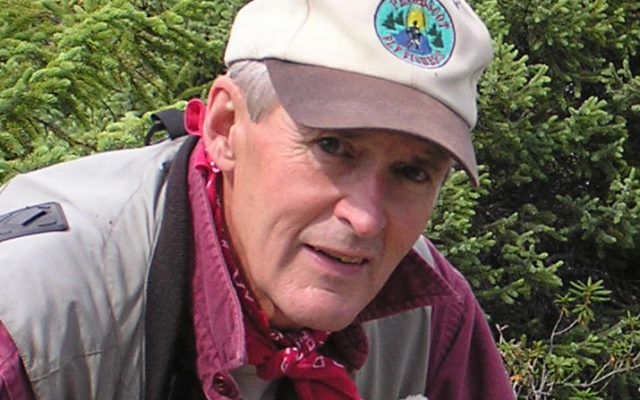
Pursuing my 1st Maine black bear harvest
By V. Paul Reynolds
In the spirit of full disclosure – you might as well know. During my five-year tenure of self-guided black bear hunts, I never bagged a bruin. However, my late wife, Diane, who was addicted to the adrenaline rush that accompanies most bear encounters, killed her first bear under my tutelage.
She also blew a chance of a lifetime to bag a big boar when her movement spooked the bear as he was about to gorge himself on a bait bag of goodies.
You don’t have to shoot a bear to have a fun time on a hunt. The weather in early September makes for comfortable tree stand vigils. When the shadows grow long and the wind subsides, you can hear a pin drop – or a bear sliding into view at the bait site.

BAIT STATION — A Maine black bear at a bait station.
The suspense and the solitude keeps most bear hunters on their toes.
On one of my “unsuccessful hunts,” a sow showed up beneath my tree stand with three cubs in tow – what a show. Momma bear let her cubs feed, and when it was her turn to dine, clicked her
teeth with a snapping sound and sent the youngsters scampering into the brush.
For the most entertaining half hour, I watched fully enthralled as my Ruger No. 1 in .270 Winchester remained on safety throughout it all. You just don’t shoot a sow bear with cubs.
A well planned self-guided Maine bear hunt does not happen without a lot of advance work. In August, almost a month before the legal hunt, bait sites must be strategically selected and tree stands erected. The bait – there are almost as many ‘sure fire’ sugar-based concoctions as there are bear hunters and guides – must be hung or placed in barrels well ahead of the hunt and replenished at regular intervals.
If you are fortunate enough to be guided by one of hundreds of highly professional and seasoned Maine guides, you will be hunting over a bait site that is known to be “hot.” Most bear guides have a variety of hot sites that are best used with specific wind conditions and directions.
Black bears are not known for their visual acuity, but they sure have a keen sense of smell. As bear guide and outfitter John Floyd points out, there is only so much a guide can do to ensure success. He can put you on hot bait with favorable wind conditions, but then the hunter is on their own.
Of course, the gun caliber, the hunter’s marksmanship and cool-headedness are important, but as Floyd emphasizes, tree stand behavior is really the key. He writes, “Discipline is the key factor when hunting black bears. Not following recommended practices while on stand can quickly ruin an active bear site. Noise, foreign scents and excessive movement can and will cause a bear to avoid a well-tended site for up to a week before returning to investigate – usually the day after the undisciplined hunter has left for home.”
That’s right. For most of us, sitting motionless in a tree stand for two to three hours without a smoke, a snack, a swig of water or a pit stop, ain’t no easy thing.
And we all have experienced Murphy’s Law. You sit still as a statue for two hours with nothing happening. The very moment that you tear open the Snicker’s Bar, or open a book, the long-awaited visitor is suddenly there at the bait site, and looking directly up at you with ears cocked and snout sniffing the air.
But this is what makes Maine’s bear hunt exciting and challenging, and brings the same hunters back year after year.